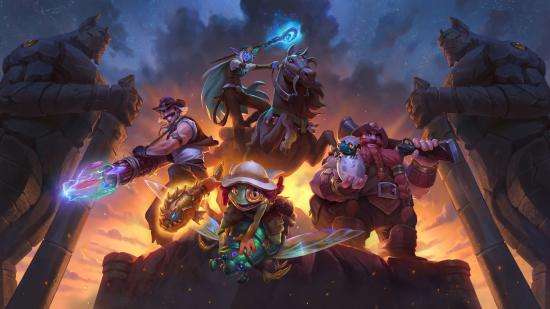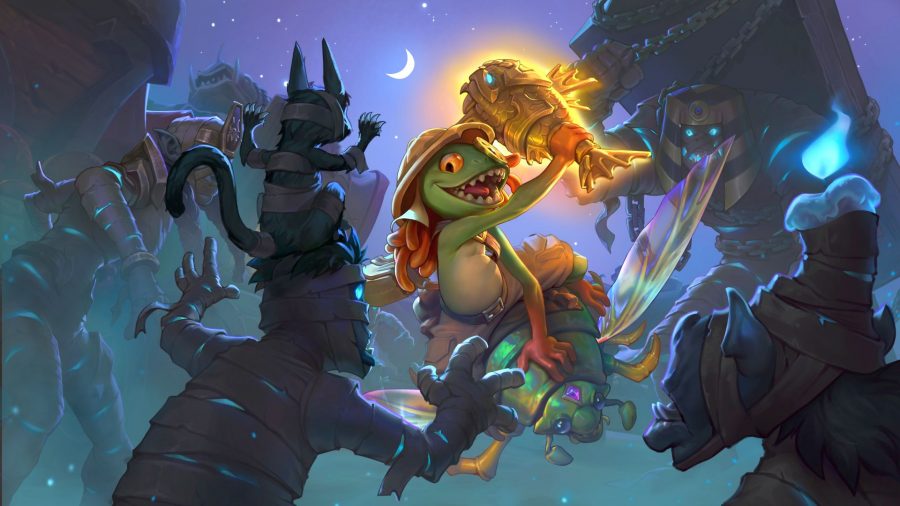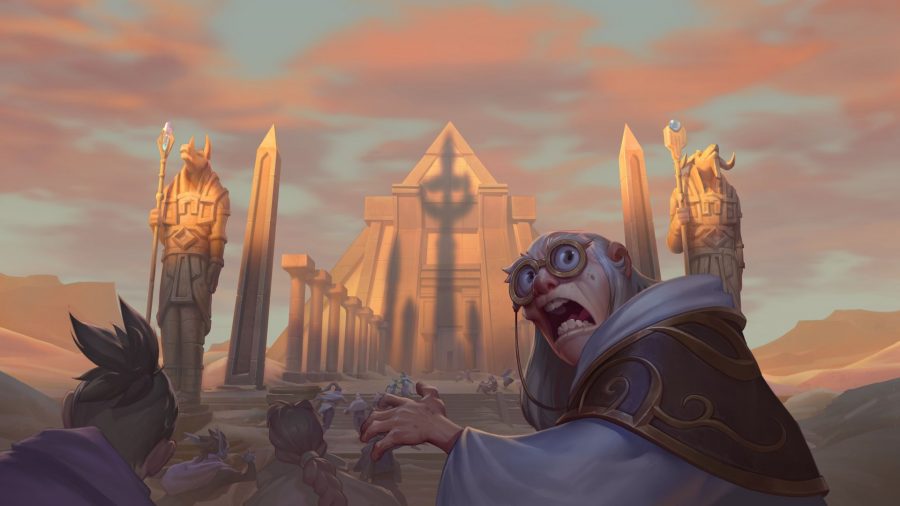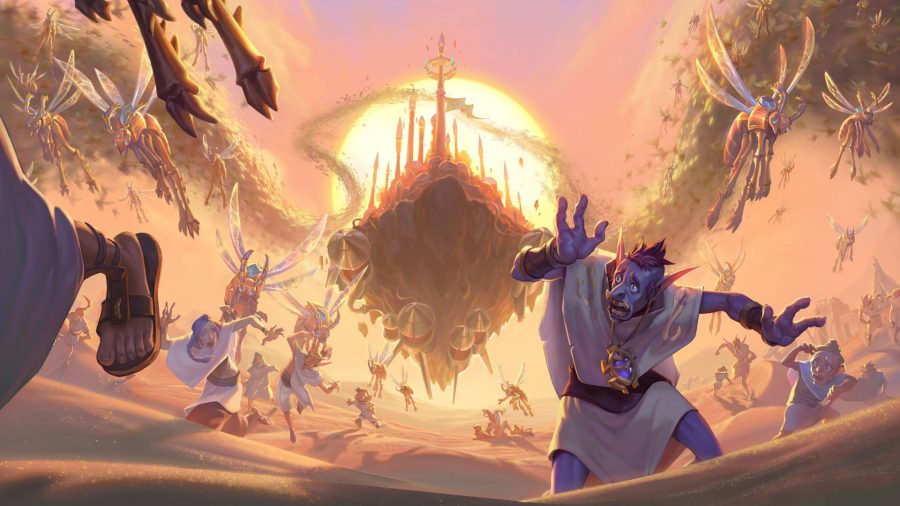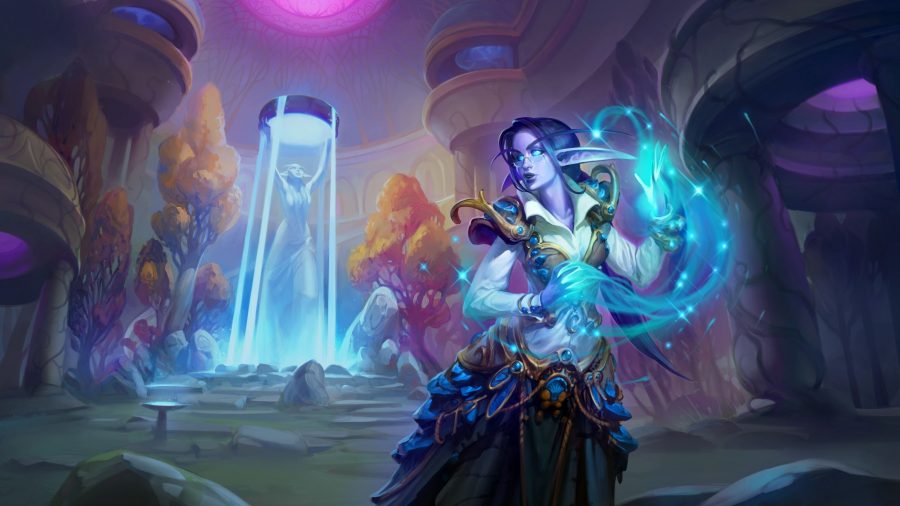The finale and fourth chapter in Hearthstone’s latest solo adventure, Tombs of Terror, goes live today, two weeks after the adventure itself.
While the Saviors of Uldum expansion has reintroduced quests with a goal of seeing “how far we can push things,” solo adventures against the AI obviously enable Blizzard’s designers to get crazier still, and indeed the goal of Tombs of Terror has been to throw typical deck-building rules “out the window“.
Lead mission designer Dave Kosak spoke with us about how the devs achieved this through a combination of returning ‘build-as-you-go’ mechanics, dual-class heroes, wacky new boss designs, wild applications of the new Reborn keyword, and plenty more. Read on for an in-depth chat about the design of Tombs of Terror, and to learn whether or not we’ll see Bartender/Bazaar Bob back again in another guise. (Possibly not a spoiler: we probably will.)
PCGamesN: What made you return to the deck-building mechanic from the last solo adventure?
Dave Kosak: Since we first rolled out the ‘build-as-you-go’ mechanic in the original dungeon run, we knew there were lots of different gameplay angles to explore in the future. Tombs of Terror adds a lot of features that fit the League of Explorers theme, including dual-class deck-building and deeper character progression. These modes continue to be a really popular way for people to play Hearthstone.

After the release of the Dalaran Heist solo adventure, did you find that players engaged more with content released over a period of weeks?
When we launched Kobolds and Catacombs, we released the new dungeon run mode at the same time as the collectable set. We learned that it really split up the players – if you wanted to play the cool new mode, you missed out on the best time to play ranked PvP games, when everyone was experimenting with crazy decks and the meta was unsettled.
Delaying the solo adventures makes a big difference – it gives people a chance to play with all the new cards, and then a few weeks later they can romp through a new adventure themed around them. Starting with the Dalaran Heist, we put so much content into the solo adventure that we could roll it out over a couple of weeks, turning each chapter into an event. It’s particularly fun in the Tombs of Terror, because each chapter has its own set of bosses – as you defeat the chapter those bosses roam out into the other chapters, meaning that even older chapters will change over time as you explore more and more content.
How did you go about designing the bosses and Plague Lords in Tombs of Terror?
The mission team has gotten pretty confident designing bosses for this type of game mode. The best ones have a relatively simple mechanic and obvious threat that you struggle against, a real test of your deck-building prowess. What’s great is that the bosses are self-balancing. If we find that a boss mechanic turns out to be really difficult, we can move it later in the tombs, when the player has more treasures and tricks up his or her sleeve.
The Plague Lords were an interesting challenge. The key idea behind them – that they’re huge bosses that take several tries to beat, but with health that’s saved from one run to the next – remained pretty much unchanged from the original design. In previous adventures the end boss had to be difficult but it was a win/lose situation, which can be awfully punishing. This way, even if you don’t beat the Plague Lord, you at least have the satisfaction of doing some damage to it. It’s a great way to make the adventure more playable for a wide variety of skill levels. It also gives our highly skilled players something to aspire to – the fantasy that you can draft a deck so good that you could take one of these monsters out in a single try.
Of course, just having 300 health could make for a static fight, and we wanted to have big moments in there so that it felt more like a World of Warcraft raid boss. So the bosses have three different hero powers, and switch up their strategy throughout the fight. After some trial and error we made these moments into big ‘thresholds,’ giving the boss a chance to reload their decks and do something nasty to the player in the process. With four Plague Lords that meant designing 12 hero powers, and ensuring they interacted with the plot twists for that chapter in interesting ways. There was a great deal of trial and error, and a lot of tinkering with the plot twists themselves.
Why did you decide to include dual-class heroes in this solo adventure? Were there any combinations of dual-class heroes that didn’t work in the playtesting stage?
Dual-class heroes were one of those ideas we’d wanted to play with for quite a while. They provide some really intense combinations that you normally don’t get to see in Hearthstone, and make all the deck-building decisions you make along the way very spicy. We paired up the classes mostly on thematic grounds. The one that we were the most worried about was Elise – Druid and Priest. We weren’t sure there were a lot of deck-building potential there, so we implemented her first. Turns out there are plenty of ways the two classes can combo together, especially if we lean into it with custom Hero Powers. You could do small spells, big minions, play around with healing or hero attacks… it turned out there were lots of great builds, so we felt comfortable moving forward.
How does the new keyword, Reborn, fit in with this particular solo adventure?
Reborn was a lot of fun to play with! Many of the bosses in the tombs take advantage of it. And we could also use it for cool new treasures, like Mummy Magic, a treasure that automatically gives all of your Deathrattle minions the Reborn keyword.
There are new twists in this expansion, the first of which is Murlocs invading your deck. Can you tell us a little about the others? Do you see this mechanic functioning outside solo adventures?
We introduced twists in The Dalaran Heist adventure – each chapter had its own quirks that you had to navigate, based on the location you were exploring. This time around we had the opportunity to link the twists to the specific Plague Lord that you’re fighting. They pop up to taunt and torment you as you fight your way toward them. We designed the twists to be symmetrical – crazy things happen that impact both players, and it’s up to you to navigate the challenge better than the bosses you fight.
For example, in the second chapter, the Plague Lord of Madness causes your right-most minion to attack a random enemy at the end of your turn. This creates some difficulty – you might lose a minion you really wanted to conserve – but also an opportunity, since it’s essentially a free attack that you can take advantage of. Chapter four’s twist has the Plague Lord of Wrath causing chaos by giving minions +1 attack every time they survive damage. This is something that skilled players can take advantage of, especially if they’ve got a lot of healing available. Of course, if you’re not careful, the bosses can get some really powerful minions! It’s doubtful that we would ever include twists like these in ranked games, but it’s the perfect kind of thing to explore in Tavern Brawls or other game modes.
‘Zephrys the Great’ is a really interesting card in the new meta, but you have a variation of the card just being a spell in the solo adventures. Was this to avoid the duplicates condition?
Although it was possible to build no-duplicates decks in the build-as-you-go format, they tended not to be as much fun to play. A great deal of player power in the Tombs of Terror comes from doing ‘illegal’ things with your deck, like multiple copies of the same Legendary, or more than two copies of a powerful common card. We love the effect, though, so giving players access to Zephrys’s Lamp (a treasure that allows you to make a wish regardless of the composition of your deck, at the expense of not playing a minion on the board) was a good compromise. I’d suggest taking that treasure often, because there’s an Easter egg associated with it.
Bartender Bob is back as Bazaar Bob, do you think he’s a staple for the foreseeable future?
We were completely surprised at how much that character resonated with players. Going into the tavern is a really fun gameplay moment and it allows you to do some crazy things to the deck you’re building, so I suspect we’ll see more of Bob. He’s got a couple tricks up his sleeve in the Tombs of Terror: players can get a VIP membership to his tavern, giving them even more minions and deck-altering options. Also, there’s a new ‘Hearthstone’ treasure that allows you to escape from a fight you’re losing, return to the tavern to adjust your deck, and then try the fight again. It’s great to use against the Plague Lords!
Was there ever a consideration of bringing the new quests into the solo adventure format?
Absolutely! Both old and new quests are available for treasure seekers in the Tombs of Terror. They’ll appear as loot alongside cards that will help you complete the quest. Reno Jackson, for instance, might find the Honor Among Thieves loot chest, which includes the Bazaar Burglary quest in addition to rogue burglar-style cards and mage spells that discover new cards for you, all of which helps complete the quest.
The old Un’goro quests also make an appearance: Brann Bronzebeard might run across the Fire Plume’s Heart quest, alongside a lot of taunt minions that will help him to complete it. Building decks around quests and then combining the quest rewards with some of the new treasures is a great way to rampage through the tombs.
As with a regular dungeon run, players get packs of three cards each win to choose from. Is there ever an interaction between the AI and the deck to offer useful cards, or are they always completely randomised?
Although it’s invisible to the player, there’s a great deal of logic that goes into generating those loot choices. For instance, most loot chests have cards that are more likely to show (like Pogo Hoppers whenever Reno finds a Mech-themed loot chest), and sometimes cards that are guaranteed to show (a Card Draw-themed loot chest will always contain a Bloodmage Thalnos, Power Word: Shield, or Azure Drake whenever Elise finds one). Picking a particular type of loot makes that loot more likely to show up in future choices. We took some additional steps in Tombs of Terror to divide the loot so that you’ll likely see different choices from one run to the next. The secret is to give players a wide variety of choices, while also ensuring that the choices have synergy with one another so that you can create some powerful themed decks.
There are cards included in the solo adventures that aren’t in the regular meta. Does the design of these cards matter as much in the design process, or are they created as and when they’re needed?
The solo adventures allow the design team to explore mechanics that would be really scary in multiplayer matches. For instance, one of Reno’s signature treasures allows him to steal cards directly from the boss’s hand! That wouldn’t be fun to play against in multiplayer, but it’s super fun to be mean to the AI.
We have several different philosophies when it comes to creating treasures. Some are just meant to create really powerful moments for the player, especially if they take a couple of turns to set them up. But others are meant to support a certain type of deck or playstyle, encouraging you to build your deck a certain way. The possibilities are enormous.
